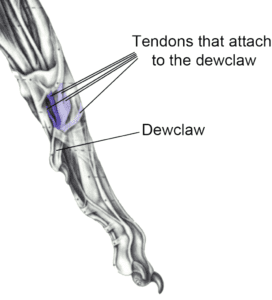Havana Silk Dogs - AKC Breeder of Merit
Natural Rearing & Dewclaw Removal
I choose not to remove the dewclaws of my Havanese. First and foremost, the health and well-being of Havana Silk Havanese are vital to every decision I make regarding their care. In choosing whether to remove dewclaws from my puppies, I am following the guidance of Dr. Chris Zink, a renowned veterinarian who specializes in working with performance dogs and devises rehabilitation programs for dogs that have suffered performance-related injuries or undergone surgery. Below is an article inspired by her website, Canine Sports.
Dr. Chris Zink:
Throughout my experience, I have encountered numerous dogs, particularly those involved in field trials, hunt tests, and agility, that suffer from chronic carpal arthritis. In many cases, the arthritis is so severe that these dogs either need to retire or be carefully managed for the remainder of their careers. Surprisingly, out of the 30-plus dogs I have observed with carpal arthritis, only one had dewclaws intact. The rest had their dewclaws removed.
You might think, “I’ve never had a dog experience carpal pain or arthritis.” However, it’s crucial to recognize that dogs naturally do not easily communicate mild to moderate pain. If an emergency room nurse asked a dog to rate their pain on a scale from 0 to 10, with 10 being the most severe, the scale would likely start at 0 and gradually increase for severe pain. Many dogs, especially those with gradually developing pain, simply tolerate it without complaining unless it becomes excruciating. However, when I examine the carpal joints of older dogs without dewclaws, I almost always elicit pain with minimal manipulation.
Regarding the possibility of dewclaw injuries, most veterinarians agree that such injuries are relatively uncommon. In the rare event that an injury does occur, it can be treated like any other injury. It is far more sensible to address an injury when it happens rather than preemptively removing dewclaws from all dogs “just in case.”

If we refer to an anatomy book like “Miller’s Guide to the Anatomy of Dogs,” we can see that the dewclaw is connected to five tendons. Each tendon is linked to a muscle, meaning that removing the dewclaw will cause atrophy in five muscle bundles due to lack of use.
These muscles serve a purpose: to prevent torque on the dog’s leg. When a dog is cantering or galloping and its foot touches the ground, the dewclaw makes contact as well. If the dog needs to change direction, the dewclaw provides support to the lower leg and prevents torque. Without a dewclaw, the leg twists, and repeated instances of this can lead to carpal arthritis over time. It’s important to remember that the dog is engaging in these activities regardless, and the pressures on the leg must be absorbed somewhere. The dewclaw acts as a buffer, but without it, the strain will transfer up and down the leg, affecting the toes, carpus, elbow, and shoulders.
